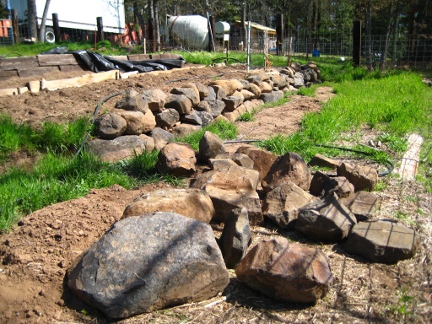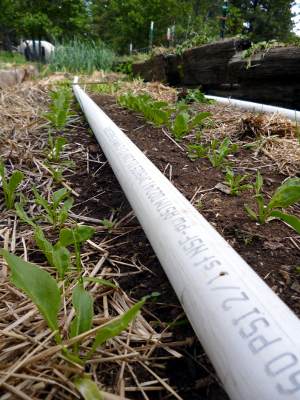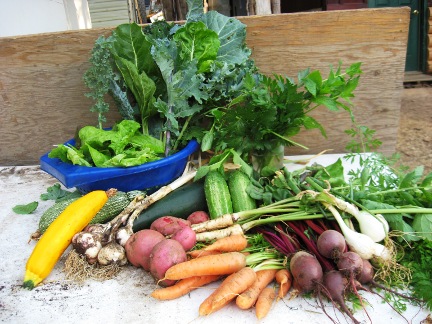


|
Commenced:
|
01/01/1988 |
|---|---|
|
Submitted:
|
25/12/2012 |
|
Last updated:
|
07/10/2015 |
|
Location:
|
55 windward lane, klickitat, washington , US |
|
Website:
|
www.windward.org |
|
Climate zone:
|
Cold Temperate |
(projects i'm involved in)
Project: Windward
Posted by Andrew Schreiber almost 12 years ago
-----Images are below this Post-----
Scope
This garden provides the primary vegetables, and all the potatoes for concurrent community of 5 people currently. With the addition of bulk grains and beans, and products from our livestock (meat, eggs and milk) along with some moderate degree of purchased food to supplement what we are surrently not growing, or cannot yet provide for interns, apprentices, guests and events.
This is Windward's zone-1 garden. While it is integrally connected with a larger permaculture landscape, I am endeavouring to describe in detail each of the pieces, so I can then describe more about how the systems fit together; and where we are going with the 131 acre system which is being designed to provide the food, fuel, clothing, fiber, craft and building materials for a community of between 20-30 people.
This annual garden was an inheritence from past community members. In 2008 it was only a fraction of the size and efficiency of what it is today, and we are working to drought-proof the system so as to need less overall water and time inputs.
Scale
The total size of the garden is about 120ft by 200ft (24000 sqft or 1/2 acre).
The site is south facing, on a slope of appx 3ft drop for every 10ft.
There are a few large oak trees on the East and West edge of the garden, outside the fencing with provide the ends of the beds with shade.
The garden is other wise open, and situated between a mature conifer forest with tall mature trees. The trees begin about 150 ft from the outside of the garden and provide addition afternon and morning shade throughout the year.
Terraces
We have 3 terraces with ft tall rock or railroad tie retaining walls. Each terrace has a central path and double reach beds on either side.
Each terrace is about 80 feet long. Each of the beds on each terrace totals about 320 sqft. With the six beds total that is about 2000 sq feet of garden bed.
Each bed has about 1ft of high quality topsoil in it. It has our primary work over the last four years to be conditioning the soil with the addition of compost and manure from Sheep, Goats, Rabbits and Chicken. At this point it is an island of fertility.
The terraces have gone a long way toward stopping water and allowing it to soak into the soil.
Other raised and sunken beds
We have about 12 large tractor tires we use as raised beds. Eventually these will be phased out as we build another terrace of similar dimensions as outlined before. Currently the tractor tires provide about half as much growing space as a terrace bed system would.
Along the northern end of the garden we have medicinal and nectary plant bed that is relatively wild. sage, sunflowers, echinacea, chamomile, calendula, comfrey and borage.
On the Western edge of the garden, running north-south is a sunken ben with primarily cultivated strawberries, totaling about 40sqft.
On the Eastern edge is an additional flower/nectary bed. As well as three mushroom beds which are located underneath the oak trees to help provide them shade.
Irrigation
The watering system we primarily utilize for the main garden is part of a larger gravity fed water system from a duck-based aquaponics system (aka duck-ponics).
Water overflows from a main potable water tank into a secondary holding tank, which feeds the duck pond (a 1200 gal septic tank) via a float valve like those commonly found in toilets, but much larger.
A siphon house runs from the duck pond across another area to a 300 gallon holding tank. The pond water is fertilized by the ducks and provides liquid living manure water for a modified drip irrigation system for the annual garden. We have to use a pump to get enough head to water the garden beds which are only a few feet lower in elevation that the bottom of the 300 gallon holding tank.
Crops
For the most part, the annualcrops that we grow and are looking to grow are ones that take advantage of the moisture available in the early spring and then again in the fall, as well as cultivars that do well in hot, dry climates.
This makes for an interesting combination of cool climate crops such as:
brassicas, lettuces and peas,
root/tuber crops such as potatoes, carrots, turnips and beets
and hot climate crops including
dry corn,
shell beans
summer squash
peppers, tomatoes, and eggplant.
We are working to develop land specific cultivars which are well adapted to the relatively odd conditions of this land.
Moving Toward Perennials
We are incorporating more perenial plants throughout the annul garden. Experiments with green mulches and direct planting in living ground covers (trifolium repens mostly) are underway to try and minimize the amount of mulch we have to annually.
Perennial Herbs are being planted from the edges inward to help make passive use of irrigation water, and to minimize the effects of high evaporation on sensitive crops that tends to occur on the edges of the beds.
Slow and Steady Evolution
Currently only 2/3rds of the space is in intensive cultivation. The bottom third has bee being cell grazed by sheep to build top soil in advance of a more perennial lands scape of deciduous fruit trees and bushes.
This area will also provide moderate summer shade to crops generally tends to get battered by the long summer days and heat in excess of 100F.

Terrace - central lowered walkway and two double reach beds on either side. small foot paths run along the base of the retaining walls in order to access all the sides of the beds.

A view of a rock terrace underconstruction.

tire beds in mid spring. so verdant!

Northern gate featuring a Grape vine trellis. The grape catches water the seeps out of the bottom of a tire bed and flower bed, so scarcely needs our attention as is scrambles up the wiring.

1 1/4" pvc pipe is our primary irrigation method. These are little sugar beets seedling. As the plants grow and temperatures rise, more and more mulch is added to the bed.

examples of a summer harvest
You must be logged in to comment.
Note: The various badges displayed in people profiles are largely honesty-based self-proclamations by the individuals themselves. There are reporting functions users can use if they know of blatant misrepresentation (for both people and projects). Legitimacy, competency and reputation for all people and projects can be evidenced and/or developed through their providing regular updates on permaculture work they’re involved in, before/after photographs, etc. A spirit of objective nurturing of both people and projects through knowledge/encouragement/inspiration/resource sharing is the aim of the Worldwide Permaculture Network.
 |
MemberA member is a permaculturist who has never taken a PDC course. These cannot become PDC teachers. Members may be novice or highly experienced permaculturists or anywhere in between. Watch their updates for evaluation. |
|---|---|
  |
Permaculture MatchmakerOne of these badges will show if you select your gender and the "I'm single, looking for a permaculture partner" option in your profile. |
 |
PDCPeople who claim to have taken a Permaculture Design Certificate (PDC) course somewhere in the world. |
 |
PDC VerifiedPeople who have entered an email address for the teacher of their PDC course, and have had their PDC status verified by that teacher. Watch their updates for evaluation. |
 |
PRI PDCPeople who’ve taken a Permaculture Research Institute PDC somewhere in the world. |
 |
PDC TeacherPeople who claim to teach some version of PDC somewhere in the world. |
 |
PRI TeacherWith the exception of the ‘Member’ who has never taken a PDC, all of the above can apply to become a PRI PDC Teacher. PRI PDC Teachers are those who the PRI recognise, through a vetting board, as determined and competent to teach the full 72-hour course as developed by Permaculture founder Bill Mollison – covering all the topics of The Designers’ Manual as well as possible (i.e. not cherry picking only aspects the teacher feels most interested or competent in). Such teachers also commit to focussing on the design science, and not including subjective spiritual/metaphysical elements. The reason these items are not included in the PDC curriculum is because they are “belief” based. Permaculture Design education concerns itself with teaching good design based on strategies and techniques which are scientifically provable. PRI PDC Teachers may be given teaching and/or consultancy offerings as they become available as the network grows. |
 |
Aid WorkerThe individual with this badge is indicating they are, have, or would like to be involved in permaculture aid work. As such, the individual may or may not have permaculture aid worker experience. Watch their updates for evaluation. |
 |
ConsultantThe individual with this badge is indicating they are, have, or would like to do paid permaculture design consultancy work. As such, the individual may or may not have permaculture consultancy experience. Watch their updates for evaluation. |
 |
Community ProjectCommunity projects are projects that help develop sustainable community interaction and increase localised resiliency. |